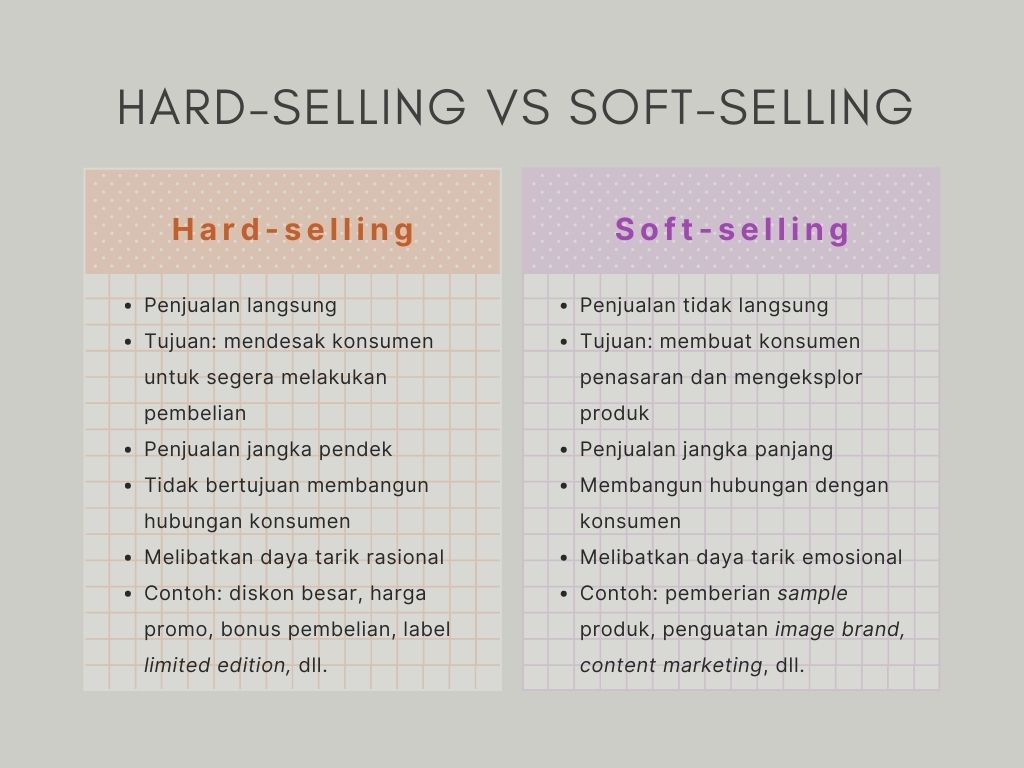4 Differences Between Hard Selling and Soft Selling You Need to Know
Hard selling and soft selling, marketing techniques that are both profitable for sales.
As part of the marketing who intensively carry out promotional strategies, the people in this section must be very familiar with it hard selling and soft selling. However, this article is not for them, but for those of you who don't really understand the two terms.
Starting from understanding, differences, to examples hard selling and soft selling, I will explain everything comprehensively. Interested? Read on for this article!
What is Hard Selling?
Hard selling means a direct, open, and worded marketing method that can trigger a purchase transaction in no time. Sales strategy with hard selling such as urging or chasing consumers to immediately buy goods.
The sentences used always aim to make consumers regret if they miss the offer. Usually, hard selling is in the form of a limited offer, flash sales, or in the form of the phrase “limited stock”, “buy now”, and the like.
With such a form, hard selling very rarely, often not even used to maintain long-term relationships with consumers. This is one of the drawbacks hard selling, but it still has advantages on the side of fast sales.
What is Soft Selling?
Soft selling is a more subtle and less aggressive marketing method such as hard selling. The main purpose soft selling is to make consumers curious about the product, learn more about it, to decide to make a purchase.
It's a process soft selling longer and requires persuasive techniques which are also not easy. In addition, the disadvantages soft selling the other is that the purchase of the product is not as fast hard selling. In one offer, it is not impossible that there will be no purchase transaction.
However, soft selling also still has advantages, one of which can maintain long-term relationships with consumers. This is because in soft selling, the elements promoted are not only the advantages of the product, but also involve emotions to humor that can attract the attention of consumers.
Difference between Hard-Selling and Soft-Selling
From the explanation of the definition above, maybe you already understand a little about the difference hard selling and soft selling. However, you need to dive deeper into the differences between the two. Check out the differences below.
Sales period
Hard selling
Aggressive nature and impression of urgency in technique hard selling make marketing strategies more concerned with selling products than consumers. Therefore, the technique hard selling it is often used for the short term only.
Because there's no Yago's defensive effort done to understand consumers, then hard selling does not have the goal of establishing long-term relationships with consumers. Once a consumer buys, brand the person will not pay attention to whether he will buy again in the future or not.
Soft selling
It was previously mentioned that the use of soft selling intended for long-term sales. This means, the company or business must formulate a well-planned and comprehensive marketing strategy when adopting the technique soft selling.
An example of a technique soft selling is to build brand image embedded in the minds of the people. Or you can also create marketing content on social media with discussions that can be associated with products, and the like.
Consumer interest
Hard selling
Because of the purpose hard selling single, which is able to sell products in a short time, then hard selling just take advantage of a momentary attraction with the lure. Even so with consumers, he will not explore the product further after buying one product from hard selling.
For example, a package of kitchen utensils sells for Rp. 1 million and gets a bonus multi-purpose pan, but has a time limit. Well, this lure will corner consumers with the choice of buying or not, buying a multi-purpose pot bonus or not.
Soft selling
The main purpose soft selling is to spark consumer curiosity about the product or service brand a business. It can be said, in soft selling, This consumer interest is the material for launching campaign continuously.
In the results of the Business 2 Community research, customers are more interested in buying the products offered using soft selling. About 97% of them will then tell a friend about the product, 95% of them become repeat customers.
Why do consumers appear more loyal? This is because to prepare a comprehensive marketing strategy, you must understand consumer needs more deeply. That way, you can answer consumer needs more precisely.
Promotion strategy
Hard selling
According to his understanding, promotions tend to be aggressive, direct, and open. Sales with technique hard selling usually use the lure to attract the attention of consumers. For example with big discounts, purchase bonuses, promo prices, labels limited edition, and its kind.
Soft selling
Contrasts with hard selling, products sold by technique soft selling will be more subtle and persuasive. For example, sales person give sample chili products explain the advantages of the product. Or it could be by strengthening brand, maximizing content marketing, etc.
Industrial fields that use it
Hard selling
Due to its direct nature and fixed, hard selling often used by certain industries. For example, such as insurance, banking, car sales, telemarketing, banking, and the like. It is also possible for these industries to adopt soft selling for marketing strategy.
Soft selling
This technique can be used by industries that often use hard selling. However, certain industries tend to rely on soft selling to market products that cannot be promoted online hard selling, for example the cigarette industry, manufacturing, consultants, architectural firms, and the like.
Thus today's discussion is to know hard selling and soft selling ranging from understanding, differences, to examples. Both have their advantages and disadvantages, but are still useful when executed.
In addition, currently there are various creative marketing strategy ideas to promote products. It could be, a company combines the two to achieve maximum sales.
Which technique do you prefer to market your product?
Image source headers:Unsplash
Sign up for our
newsletter



